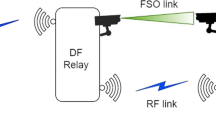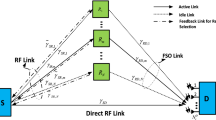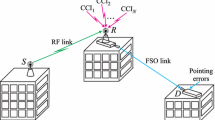Abstract
We present the performance analysis of dual-hop mixed radio frequency (RF)/free space optical (FSO) systems with fixed-gain amplify-and-forward (AF) relaying in the presence of pointing errors. The RF link undergoes the \(\kappa\)-\(\mu\) shadowed fading and the FSO link experiences Fisher-Snedecor \(\mathcal{F}\) turbulence with pointing errors. For uplink and downlink scenarios, we derive closed-form approximate expressions of the end-to-end signal-to-noise ratio (SNR) statistics, such as the cumulative distribution function (CDF) and the probability density function (PDF). By using both two statistics, the average bit error rate (BER), the ergodic capacity (EC), and the effective capacity are derived in terms of the bivariate Fox’s H function. These results illustrate the effects of system and channel parameters on the considered system, including atmospheric turbulence, pointing errors, multipath cluster numbers, shadowing parameter, quality parameter and different modulation schemes. Note that our results provide more general expressions. Finally, the derived approximate expressions are confirmed through Monte Carlo (MC) simulations. This work would contribute to the design and development of dual-hop mixed RF/FSO relaying systems.








Similar content being viewed by others
Data availability
The manuscript has no relevant data.
References
Amjad, M., Musavian, L., Rehmani, M.H.: Effective capacity in wireless networks: a comprehensive survey. IEEE Commun. Surv. Tut. 21(4), 3007–3038 (2019). https://doi.org/10.1109/COMST.2019.2929001
Andrews, L.C., Phillips, R.L.: Laser beam propagation through random media. SPIE Press Bellingham, Washington, DC, USA (2005). https://doi.org/10.1117/3.626196
Anees, S., Bhatnagar, M.R.: Performance of an amplify-and-forward dual-hop asymmetric RF-FSO communication system. J. Opt. Commun. Netw. 7(2), 124–135 (2015). https://doi.org/10.1364/JOCN.7.000124
Ansari, I.S., Al-Ahmadi, S., Yilmaz, F., et al.: A new formula for the BER of binary modulations with dual-branch selection over generalized-\(K\) composite fading channels. IEEE Trans. Commun. 59(10), 2654–2658 (2011). https://doi.org/10.1109/TCOMM.2011.063011.100303A
Ansari, I.S., Yilmaz, F., Alouini, M.S.: Impact of pointing errors on the performance of mixed RF/FSO dual-hop transmission systems. IEEE Wireless Commun. Lett. 2(3), 351–354 (2013). https://doi.org/10.1109/WCL.2013.042313.130138
Ashrafzadeh, B., Soleimani-Nasab, E., Kamandar, M., et al.: A framework on the performance analysis of dual-hop mixed FSO-RF cooperative systems. IEEE Trans. Commun. 67(7), 4939–4954 (2019). https://doi.org/10.1109/TCOMM.2019.2904501
Boluda-Ruiz, R., García-Zambrana, A., Castillo-Vázquez, B., et al.: On the capacity of MISO FSO systems over gamma-gamma and misalignment fading channels. Opt. Express 23(17), 22371–22385 (2015). https://doi.org/10.1364/OE.23.022371
Bouteggui, M., Merazka, F., Kurt, G.K.: The effective capacity of two-unicast network coding STBC under retransmission schemes. Digit. Signal Process. 106, 102819 (2020). https://doi.org/10.1016/j.dsp.2020.102819
Ding, J., Xie, X., Tan, L., et al.: Dual-hop RF/FSO systems over \(\kappa\)-\(\mu\) shadowed and fisher-snedecor \({\cal{F} }\) fading channels with non-zero boresight pointing errors. J. Lightwave Technol. 40(3), 708–719 (2022). https://doi.org/10.1109/JLT.2021.3120767
Ding, J., Xie, X., Wang, L., et al.: Performance of dual-hop FSO/RF systems with fixed-gain relaying over fisher-snedecor \(\cal{F}\) and \(\kappa\)-\(\mu\) shadowed fading channels. Appl. Opt. 61(8), 2079–2088 (2022). https://doi.org/10.1364/AO.448381
Goel, A., Bhatia, R.: On the performance of mixed user diversity-RF/spatial diversity-FSO cooperative relaying AF systems. Opt. Commun. 477, 126333 (2020). https://doi.org/10.1016/j.optcom.2020.126333
Goel, A., Bhatia, R.: Hybrid RF/MIMO-FSO relaying systems over gamma–gamma fading channels. In: International Conference on Innovative Computing and Communications, Springer, pp 607–615, (2021a) https://doi.org/10.1007/978-981-15-5113-0_49
Goel, A., Bhatia, R.: Joint impact of interference and hardware impairments on the performance of mixed RF/FSO cooperative relay networks. Opt. Quantum Electron. 53(9), 1–15 (2021). https://doi.org/10.1007/s11082-021-03064-x
Gradshteyn, I.S., Ryzhik, I.M.: Table of integrals, series, and products. Academic Press, New York, NY, USA (2014). https://doi.org/10.1016/c2010-0-64839-5
He, B., Schober, R.: Bit-interleaved coded modulation for hybrid RF/FSO systems. IEEE Trans. Commun. 57(12), 3753–3763 (2009). https://doi.org/10.1109/TCOMM.2009.12.080396
Huang, L., Liu, S., Dai, P., et al.: Unified performance analysis of hybrid FSO/RF system with diversity combining. J. Lightwave Technol. 38(24), 6788–6800 (2020). https://doi.org/10.1109/JLT.2020.3018125
Kilbas, A.A.: H-transforms: theory and applications. CRC Press, Boca Raton, FL, USA (2004)
Krishnan, P.: Performance analysis of hybrid RF/FSO system using BPSK-SIM and DPSK-SIM over gamma-gamma turbulence channel with pointing errors for smart city applications. IEEE Access 6, 75025–75032 (2018). https://doi.org/10.1109/ACCESS.2018.2881379
Lee, E., Park, J., Han, D., et al.: Performance analysis of the asymmetric dual-hop relay transmission with mixed RF/FSO links. IEEE Photon Technol. Lett. 23(21), 1642–1644 (2011). https://doi.org/10.1109/LPT.2011.2166063
Miao, M., Li, X.: Novel approximate distribution of the sum of gamma-gamma variates with pointing errors and applications in MIMO FSO links. Opt. Commun. 486, 126780 (2021). https://doi.org/10.1016/j.optcom.2021.126780
Mittal, P., Gupta, K.: An integral involving generalized function of two variables. In: Proc. Indian Acad. Sci.-Section A, Springer, pp. 117–123, (1972) https://doi.org/10.1007/bf03049732
Navidpour, S.M., Uysal, M., Kavehrad, M.: BER performance of free-space optical transmission with spatial diversity. IEEE Trans. Wireless Commun. 6(8), 2813–2819 (2007). https://doi.org/10.1109/TWC.2007.06109
Niu, M., Cheng, J., Holzman, J.F.: Exact error rate analysis of equal gain and selection diversity for coherent free-space optical systems on strong turbulence channels. Opt. Express 18(13), 13915–13926 (2010). https://doi.org/10.1364/OE.18.013915
Niu, M., Cheng, J., & Holzman, JF.: et al Coherent free-space optical transmission with diversity combining for gamma-gamma atmospheric turbulence. In: 2010 25th Biennial symposium on communications, pp. 217–220, (2010b) https://doi.org/10.1109/BSC.2010.5472924
Paris, J.F.: Statistical characterization of \(\kappa\)-\(\mu\) shadowed fading. IEEE Trans. Veh. Technol. 63(2), 518–526 (2014). https://doi.org/10.1109/TVT.2013.2281213
Peppas, K.P.: A simple, accurate approximation to the sum of gamma-gamma variates and applications in MIMO free-space optical systems. IEEE Photon Technol. Lett. 23(13), 839–841 (2011). https://doi.org/10.1109/LPT.2011.2135342
Peppas, K.P., Alexandropoulos, G.C., Xenos, E.D., et al.: The fischer-snedecor \({\cal{F} }\)-distribution model for turbulence-induced fading in free-space optical systems. J. Lightwave Technol. 38(6), 1286–1295 (2020). https://doi.org/10.1109/JLT.2019.2957327
Samimi, H., Uysal, M.: End-to-end performance of mixed RF/FSO transmission systems. J. Opt. Commun. Netw. 5(11), 1139–1144 (2013). https://doi.org/10.1364/JOCN.5.001139
Singya, P.K., Alouini, M.S.: Performance of UAV-assisted multiuser terrestrial-satellite communication system over mixed FSO/RF channels. IEEE Trans. Aerosp. Electron. Syst. 58(2), 781–796 (2022). https://doi.org/10.1109/TAES.2021.3111787
Sun, Q., Zhang, Z., Zhang, Y., et al.: Performance analysis of dual-hop wireless systems over mixed FSO/RF fading channel. IEEE Access 9, 85529–85542 (2021). https://doi.org/10.1109/ACCESS.2021.3085821
Trinh, P.V., Thang, T.C., Pham, A.T.: Mixed mmwave RF/FSO relaying systems over generalized fading channels with pointing errors. IEEE Photon J. 9(1), 1–14 (2016). https://doi.org/10.1109/JPHOT.2016.2644964
Tsiftsis, T.A., Sandalidis, H.G., Karagiannidis, G.K., et al.: Optical wireless links with spatial diversity over strong atmospheric turbulence channels. IEEE Trans. Wireless Commun. 8(2), 951–957 (2009). https://doi.org/10.1109/TWC.2009.071318
Upadhya, A., Dwivedi, V.K., Alouini, M.S.: Interference-limited mixed MUD-RF/FSO two-way cooperative networks over double generalized gamma turbulence channels. IEEE Commun. Lett. 23(9), 1551–1555 (2019). https://doi.org/10.1109/LCOMM.2019.2924217
Upadhya, A., Dwivedi, V.K., Singh, G.: Multiuser diversity for mixed RF/FSO cooperative relaying in the presence of interference. Opt. Commun. 442, 77–83 (2019). https://doi.org/10.1016/j.optcom.2019.02.040
Upadhya, A., Dwivedi, V.K., Karagiannidis, G.K.: On the effect of interference and misalignment error in mixed RF/FSO systems over generalized fading channels. IEEE Trans. Commun. 68(6), 3681–3695 (2020). https://doi.org/10.1109/TCOMM.2020.2971496
Usman, M., Yang, H.C., Alouini, M.S.: Practical switching-based hybrid FSO/RF transmission and its performance analysis. IEEE Photonics J. 6(5), 1–13 (2014). https://doi.org/10.1109/JPHOT.2014.2352629
Wolfram Research Inc. “The Wolfram Functions Site,” [Online]. Available: http://functions.wolfram.com. (2020)
Xu, G., Song, Z.: Performance analysis for mixed \(\kappa\)-\(\mu\) fading and \({\cal{M} }\)-distribution dual-hop radio frequency/free space optical communication systems. IEEE Trans. Wireless Commun. 20(3), 1517–1528 (2021). https://doi.org/10.1109/TWC.2020.3034104
Yang, L., Hasna, M.O., Gao, X.: Performance of mixed RF/FSO with variable gain over generalized atmospheric turbulence channels. IEEE J. Sel. Areas Commun. 33(9), 1913–1924 (2015). https://doi.org/10.1109/JSAC.2015.2432471
Yang, L., Hasna, M.O., Ansari, I.S.: Unified performance analysis for multiuser mixed \(\eta\)-\(\mu\) and \({\cal{M} }\)-distribution dual-hop RF/FSO systems. IEEE Trans. Commun. 65(8), 3601–3613 (2017). https://doi.org/10.1109/TCOMM.2017.2700462
Zedini, E., Ansari, I.S., Alouini, M.S.: Performance analysis of mixed Nakagami-\(m\) and Gamma-Gamma dual-hop FSO transmission systems. IEEE Photon J. 7(1), 1–20 (2015). https://doi.org/10.1109/JPHOT.2014.2381657
Zedini, E., Soury, H., Alouini, M.S.: On the performance analysis of dual-hop mixed FSO/RF systems. IEEE Trans. Wireless Commun. 15(5), 3679–3689 (2016). https://doi.org/10.1109/TWC.2016.2524685
Zhang, J., Dai, L., Zhang, Y., et al.: Unified performance analysis of mixed radio frequency/free-space optical dual-hop transmission systems. J. Lightwave Technol. 33(11), 2286–2293 (2015). https://doi.org/10.1109/jlt.2015.2409570
Zhang, J., Wang, Z., Dai, L., et al.: Effective capacity of communication systems over \(\kappa\)-\(\mu\) shadowed fading channels. IET Electron. Lett. 51(19), 1540–1542 (2015). https://doi.org/10.1049/el.2015.1032
Zhang, W., Hranilovic, S., Shi, C.: Soft-switching hybrid FSO/RF links using short-length raptor codes: design and implementation. IEEE J. Sel. Areas Commun. 27(9), 1698–1708 (2009). https://doi.org/10.1109/JSAC.2009.091219
Funding
This work was supported by National Natural Science Foundation of China (61,705,053), China Postdoctoral Science Foundation (2016M600249), Heilongjiang Provincial Postdoctoral Science Fundation, Fundamental Research Funds for the Central Universities, the Major Key Project of PCL (PCL2021A03-1).
Author information
Authors and Affiliations
Contributions
JD: Conceptualization, Methodology, Software. DK: Funding acquisition, Writing- Original draft preparation, Supervision, Validation. XX: Formal analysis, Writing- Reviewing and Editing. LW: Formal analysis, Mathematical formula derivation. HW: Formal analysis, Writing- Reviewing and Editing. LT: Writing- Reviewing and Editing. JM: Supervision.
Corresponding author
Ethics declarations
Conflict of interest
The authors declare that they have no known competing financial interests or personal relationships that could have appeared to influence the work reported in this paper.
Ethical approval
This declaration is not applicable.
Additional information
Publisher's Note
Springer Nature remains neutral with regard to jurisdictional claims in published maps and institutional affiliations.
Appendices
Appendix A Proof of Eq. (8)
The CDF of \(\gamma\) can be written as
Integrating over the same region and interchanging the integration order, we obtain
Inserting (3), (4), and (7) into (A.2) yields
Using the change of variable \(x=t-\gamma\), resorting to Eq. (2.9.1) in Kilbas (2004) and expanding the Fox’s H function using Eq. (1.1.1) in Kilbas (2004), \({{F}_{\gamma }}\left( \gamma \right)\) can be derived as
where \({{\mathcal {C}}_{1}}\) and \({{\mathcal {C}}_{2}}\) represent the t-plane and the s-plane contours, respectively.
Employing Eq. (1.1) in Mittal and Gupta (1972), \({{F}_{\gamma }}\left( \gamma \right)\) can be derived in closed form as (8).
Appendix B Proof of Eq. (9)
Differentiating (A.4) with respect to \(\gamma\), the PDF of \(\gamma\) can be expressed as
With the help of Eq. (1.1) in Mittal and Gupta (1972), \({{f}_{\gamma }}\left( \gamma \right)\) can be obtained in closed form as (9).
Appendix C Proof of Eq. (14)
Inserting (8) into (13) and then employing Eq.(3.381/4) in Gradshteyn and Ryzhik (2014), \(\bar{P}_{e}\) can be obtained as
Applying Eq. (1.1) in Mittal and Gupta (1972), \(\bar{P}_{e}\) can be derived in closed form as (14).
Appendix D Proof of Eq. (21)
Substituting (B.1) into (20), \(\overline{C}\) can be expressed as
To evaluate (D.1), we can express the logarithmic function as Meijer’s G-function by
Then employing Eq. (07.34.21.0009.01) in Wolfram Research Inc. (2020), \(\overline{C}\) can be obtained as
Applying Eq. (1.1) in Mittal and Gupta (1972), \(\overline{C}\) can be expressed in closed form as (21).
Rights and permissions
Springer Nature or its licensor (e.g. a society or other partner) holds exclusive rights to this article under a publishing agreement with the author(s) or other rightsholder(s); author self-archiving of the accepted manuscript version of this article is solely governed by the terms of such publishing agreement and applicable law.
About this article
Cite this article
Ding, J., Kang, D., Xie, X. et al. Generalized performance analysis of uplink and downlink dual-hop AF mixed RF/FSO relaying systems with pointing errors. Opt Quant Electron 55, 766 (2023). https://doi.org/10.1007/s11082-023-05054-7
Received:
Accepted:
Published:
DOI: https://doi.org/10.1007/s11082-023-05054-7




